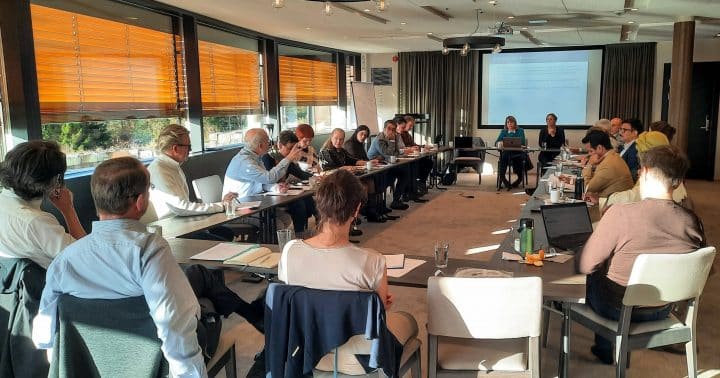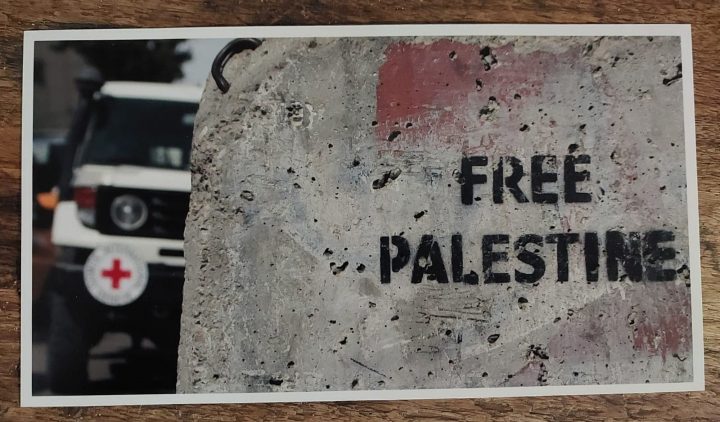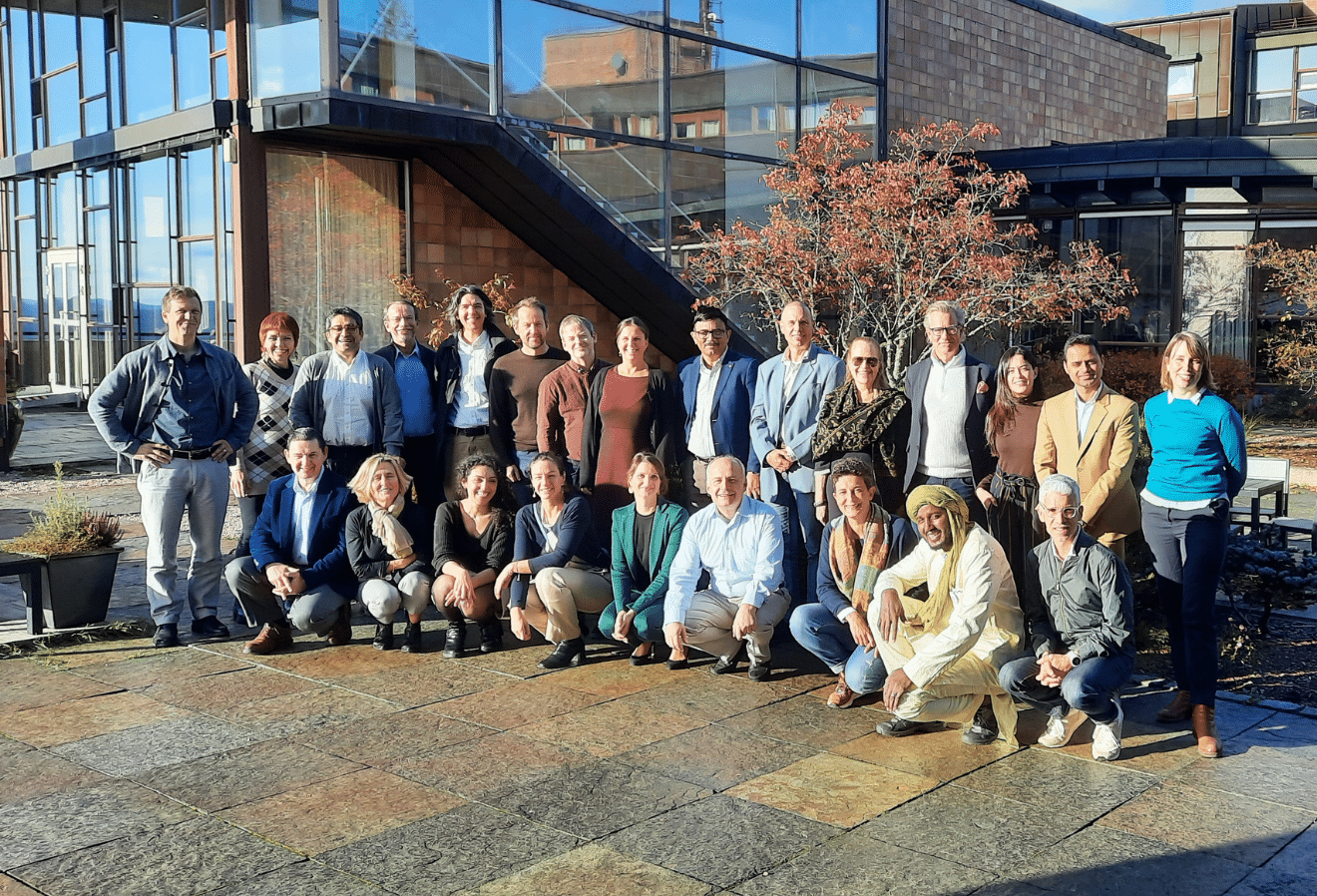This blog post includes the following contributions:
1. Ethical dilemmas in humanitarian negotiations, by Kristoffer Lidén and Kristina Roepstorff
2. Challenges to neutrality and impartiality, and their value, by Jérôme Grimaud
3. No political vacuum during humanitarian operations and negotiations, by Carsten Wieland
5. Community based humanitarian negotiations in Colombia, by Manuel Salamanca
6. Mediterranean search and rescue: What dilemmas exist (if any)? by Maria Gabrielsen Jumbert
See also the related blog post Reflections on humanitarian negotiation by Hugo Slim (University of Oxford).
By Kristoffer Lidén and Kristina Roepstorff (Peace Research Institute Oslo, PRIO)
Humanitarian negotiations – the negotiations with political authorities, armed groups and local communities for access, assistance and protection that have always been part of humanitarian action – are filled with ethical challenges and dilemmas. These include for example which compromises are acceptable, who should humanitarians talk to, how should the negotiations be conducted, and which principles should they adhere to? The intricacies of these questions are tragically illustrated in the current situation in Gaza and related debates in the United Nations Security Council.
With the topic of humanitarian negotiations only recently having gained attention in its own right, a good understanding of these ethical dilemmas and how humanitarian organisations respond to them is still lacking. In a three day workshop that took place from 4 to 6 October 2023 in Oslo and hosted as part of the project Redlines and Grey Zones: Ethical dilemmas in humanitarian negotiations (Redlines), researchers and practitioners came together to reflect on these issues, discussing both conceptual aspects and empirical evidence.

The Redlines project seeks to understand what ethical dilemmas arise in humanitarian negotiations and how these can best be analysed. Taking the perception of practitioners as the starting point of the investigation – from the level of local humanitarian workers to the directors in the headquarters of global organisations – case studies investigate which ethical dilemmas humanitarian practitioners experience and how these are constituted by the practical settings in which they operate.
Focusing on ethical dilemmas is an expedient way of looking into the role of norms and values in these settings. This is because dilemmas: (1) involve situations where the practicing of these norms and values can no longer be taken for granted, and (2) where the tensions or contradictions between different norms and values as well as their operationalisation become apparent.
The concept of humanitarian negotiation was introduced through several manuals, handbooks and reports by organisations and humanitarian think tanks, including HD Centre, OCHA and CCHN. These have been instructive for opening an important debate on various aspects of humanitarian negotiations, ranging from questions regarding the specific features of humanitarian versus other forms of negotiations, to more practical matters such as different negotiation strategies and their logistics. While several instructive attempts have been made at more precise definitions, we start out from a broad conception of humanitarian negotiations as ‘negotiations to achieve humanitarian objectives’. This allows us to look into a wide range of actors, practices and objectives beyond frontline negotiations between formal humanitarian agencies and armed groups or authorities. In other words, it opens for meanings of humanitarian negotiation that may be highly controversial and fall outside the scope of the definitions by prevalent humanitarian organisations or our own conceptions of what is ‘truly humanitarian’.
We used to distinguish humanitarian negotiations from ‘humanitarian mediation’ by saying that negotiations involve a humanitarian agency as one of the negotiation parties, while mediation involves a humanitarian actor as third party, but we now rather see humanitarian negotiation as a broad category that can include a third party mediator or not. In our research, we have found that humanitarian agencies sometimes mediate between other agencies and authorities or armed groups because they have good connections and are trusted among both sides. (For more on humanitarian mediation, see Roepstorff and Lidén (2023) in Humanitarian mediation: Conceptual and ethical explorations.)
In both cases, and as illustrated above, humanitarian actors regularly face ethical dilemmas. As outlined by Terrance McConnell in The Stanford Encyclopedia of Philosophy, an ethical (or moral) dilemma involves a situation where an agent is morally required to do each of two (or more) actions; the agent can do each of the actions; but the agent cannot do both (or all) of the actions. The agent thus seems condemned to moral failure; no matter what she does, she will do something wrong (or fail to do something that she ought to do). A typical example from humanitarian negotiation is when the authority controlling a war-torn territory demands that its political opponents are excluded from aid as a condition for access. Humanitarian organisations are both required to help everyone in dire need and to do so in an impartial manner. When forced to act partially, this involves an ethical dilemma, as the agency can do each of the actions but not both. However, there are ways of dealing with dilemmas that involve a non-ideal compromise – and this is generally how humanitarian agencies would tackle a problem like the above. In this example, they might for instance suggest a compromise where only some types of life-saving aid is given to opposition-held areas – of a magnitude that will not really strengthen the rebels. Agencies might also divide the labour between them – where one agency accepts the conditions of the authorities while another organisation assists people in the opposition held areas without the consent of the authorities. They might also withdraw but mobilise international pressure for the authorities to soften their position. As such, the very negotiations manifest the ways in which principled humanitarian action involves, not only compromises with non-humanitarian counterparts but between different principles and concerns of the organisations themselves.
Apart from these conceptual aspects, first findings from the various case studies conducted within the framework of the Redlines project were presented and jointly reflected upon in the workshop, drawing both on the rich knowledge of experienced practitioners and the attending scholars. The workshop culminated in a thought-provoking ethical reflections by Hugo Slim. In the following sections, six other workshop participants generously share their thoughts on this complex and often sensitive topic, reflecting on the principles of neutrality and impartiality, the broader political context within which humanitarian negotiations occur, the right to reject aid, the role of community-based actors, and the humanitarian obligation to rescue migrants in distress at sea.
By Jérôme Grimaud (Senior Protection Advisor, ProCap/NorCap), 22 October 2023 (Image credit: Jérôme Grimaud©)

The unleashing. The abyssal chasm. The dizzying plunge into dehumanisation. The unthinkable carnage. Faced with the outbreak of violence in Israel and Palestine, which comes on top of those that are breaking out worldwide in the shadow of immediate media interest, the question of our neutrality and our impartiality arises. That is, our neutrality and impartiality as people, as much as humanitarian workers.
This is not only a theoretical or ethical question; it’s an almost physical challenge. The images and voices we are exposed to generate strong emotions: shock, incredulity, astonishment, despair, sadness, desolation, compassion, anger, rage, sometimes the desire to revolt. So many uncontrollable and overwhelming currents that are at war inside us. They speak to our values, sensitivity, personal and collective history. They shake us as a person, in our body and soul.
Can we, or should we, remain neutral in the face of these events? Does it still make sense in such a situation to remain ‘neutral’? Is neutrality a deliberate and assumed position, or just a screen behind which we hide our cowardice? Wouldn’t change and impactful action on the situation that people are facing, wouldn’t the idea we have of ‘justice’ require us to take part? To engage differently than through just the humanitarian lens? With more political and partisan tones and objectives? As supporters, as protectors, as defenders, as opponents? It is for every one of us to evaluate, decide and act accordingly.
And yet, there may also be a relevance, a usefulness and even a need for our neutrality and impartiality in this context.
These principles are too often presented as means to an end. We are told that neutrality and impartiality are the guarantees of acceptance and our access, so that we can deliver aid.
They actually carry much more meaning and value.
In the confrontation, parties only look at one another from the angle of dehumanisation tinged with hatred. And one may ask oneself, in this context, if Palestinians and Israelis, Ukrainians and Russians, Dogons and Peuls, Sahrawis and Moroccans really need another opinion on the situations they are facing. Whether they need our opinion on the situation. If that, indeed, will contribute to appease tension, reduce violence, create room for change.
When remaining neutral and impartial, we play an essential role as a third party between parties in conflict. We treat everyone with equal dignity. We suspend our judgement, by not discriminating. We approach everyone on a fair and equitable basis, as beings with equal human value. By creating trust with everyone, we model a behaviour that rehumanises each and every one. We embody and represent a bridge when the two banks seem to move inexorably apart. We represent a link, a connection, a channel and the possibility of a path beyond the one of confrontation. We represent a tiny, fragile, limited possibility for dialogue between human beings and communities.
In an increasingly polarised and antagonistic world, our neutral and impartial stand represents the hope that even in the darkest times, sparks of humanity may still remain.
* Inspired by the workshop that ended the day before the war broke out, this text was published by the Humanitarian Practitioner Network (HPN) of ODI as part of a forum on responses to the humanitarian situation in Gaza and Israel.
By Carsten Wieland (PRIO)
Humanitarian practitioners have to operate in tough quagmires. In this workshop it has become clear once more that they don’t operate in a political vacuum and that many decisions humanitarians have to take are also political ones in nature. Many hard negotiations humanitarians have to lead with difficult and powerful partners that don’t follow humanitarian rules. But they are led in order to achieve humanitarian goals, i.e. mirroring the aspirations to achieve aid delivery in a neutral, impartial and independent manner as much as possible.
In other words, the notorious “firewall” between humanitarians and political actors has its clear merits in operative contexts on the ground. But those working on humanitarian files in donor institutions have to take political considerations, restrictions and broader horizons into account when deciding about the best way to spend the money that is supposed to reach people in need in a principled way.
The participants in the workshop also discussed historical and topical cases where compromises had to be found between delivering aid to some or to none, between doing good and even doing harm. Those who have been in such dilemmatic situations on the ground know best how difficult it is to find an across-the-board answer to such problems. That is why the composition of the workshop was highly beneficial, offering a unique setting where practitioners, academics and diplomats could exchange views on principles and concrete cases.
The discussions evolved also around the question on how to differentiate between humanitarian actors and peace-building actors on the ground. Oftentimes, they are confused in terms of activities and goals. However, both types of engagements may be seen as disturbing, undermining and dangerous from the point of view of certain warring parties.
Parties to the war react differently with regard to humanitarian actors. There are cases where aid workers and their agencies have been expelled by a party because they are considered biased, an obstacle to full-fledged warfare or even an agent of the enemy. In other cases, such as in Syria, the stronger party like the state or the wider regime invited humanitarian actors to stay in the country under its strict supervision and conditions, since it was conscious of the beneficial effects of humanitarian resources to the country and its war economy. Systematic abuse, manipulation or refusal of principled aid deliveries can become a means of warfare, fuel the conflict, and has to be recognised as such. Otherwise, humanitarian funding and actions without considering such adverse political contexts fall into the “neutrality trap”.
By Lars Christie (Inland Norway University of Applied Sciences)
Some of the debate on the cross border versus cross line aid to Syria focuses entirely on big politics in UN Security Council and political will in Western countries. Temporarily bracketing these dynamics, the following dilemma focuses on the politics on the ground in Syria:
What should the response of humanitarian organisations be when the local aid recipients strongly prefer some aid organisations and delivery channels of over others?
This difficult question arose during the discussion of aid to areas outside government control in Syria. In such areas, part of the population would not want to receive aid delivered by government agencies, SARC or organisations controlled by the regime. How should international humanitarian organisations take this into account? The dilemma can be stated as follows:
If the resistance of recipients is in itself taken as a sufficient reason for not cooperating with such entities (for instance by channeling aid via Damascus rather than cross border), then one may contribute to cementing the conflict between the government and the population in opposition held areas, thereby missing a chance to start building a minimally functioning relationship between the parties. In the long term, complete circumvention of Syrian authorities in the delivery of aid may contribute to a process that will end in the partition of Syria.
If recipients’ resistance is completely ignored and all aid to opposition-controlled areas is delivered on terms agreed with Damascus, one runs the risk that aid will not reach those in need (on the assumption that local authorities, who share the hostility, hold the power to block aid delivery). If the problem of implementation was overcome, it would still be morally problematic: Given that the recipients’ hostility is well-founded (at least for a large part), international humanitarian organisations may become complicit in the abuse of delivery of humanitarian aid for political purposes (gather information about regime critics, twist the distribution in a way that favor the regime etc).
The dilemma may not be seen this way by international humanitarian organisations today, however, because their stated positions is that they stand ready to coordinate with the government of Syria as soon as the government engages in meaningful political reform and dialogue. Given that the chance for political reform of the regime is very slim, the strategy followed by the humanitarian organisations operating in opposition held areas may in reality better be described as the first dilemma mentioned above of who gets to decide on the assistance.
This may resemble a much-discussed problem with the two-state solution in Israel/Palestine: Continued talk about how peace talks should lead to the establishment of two states, ignores the fact that as long as there is no peace talks in sight, current developments are fast heading towards a one-state solution.
Discussions about the preservation of Syria’s territorial integrity may suffer from similar dynamics: Talk about how political reform may pave the way for reintegrating areas currently outside government control ignores the fact that as long as there is no political reform in sight, current aid policies make it less likely that Syria’s territorial integrity is preserved.
In both cases, the hope for a political process that has little or no chance of materialising, may prevent parties from clearly seeing which outcome the actual political development is heading towards, and the dilemmas this development presents. The ethical question of how much weight to put on the preferences of local communities in conflict settings may be instructive in this regard.
By Manuel Salamanca (Universidad Javeriana, Bogotá)
Violently divided societies present a very complex conflict realm for humanitarian negotiations of the most diverse levels. In the case of Colombia, one needs to understand that a recent peace agreement has not brought a total cease-fire (there are 93 to 140 armed illegal groups reported) and has evolved to become the political scenario of diverse types of conflicts. Such a situation, typical of societies in transition, has also brought the numbers of humanitarian crises in Colombia to numbers not seen in decades. Specially, confinements and forced displacements by actors of confrontation has resulted in an unseen affectation of civilians.
In a case presented by the Colombian team, one could appreciate how humanitarian negotiation was needed to carry out a humanitarian education project in a conflict area. The best results of the negotiations were obtained when the locals (organisations and communities) carried the process.
Humanitarian negotiations imply, then, the construction of a relationship between violent actors (legal or illegal) and organisations seeking access to bring the assistance to victims of violence. Also, at a more informal level, humanitarian negotiations happen between communities and those actors who coexist in diverse territories. This situation, ethically challenging and maybe morally questionable, has been appreciated by our research in experiences where negotiations imply transfer of capacities, risks and responsibilities to communities and local civil society entities.
The question is: is that a face of localisation, in which certain procedures are assumed by the local, through adaptive and participatory methods? Or is it, instead, the result of a distance taken by the humanitarian entities, willing to face only certain challenges?
The above has led us to think about a projection of the nexus towards levels at which peace building, development, humanitarian action and conflict resolution may coincide. A complex focus of facts and problems may be the key to practically resolve questions of access and participation in deeply divided societies. Also, a means to act politically when the dilemmas of transition become the very core of coexistence and survival for impacted communities. Analysis and action need to go hand in hand. The distance between theory and practice must be reduced in order to produce knowledge focused on achieving results benefiting impacted populations. This may imply that the so-called neutrality of humanitarianism is relativised. Opting for the human and survival means political action transforming the very core of coexistence and survival for affected communities, particularly in contexts of profound divisions by violent actions.
By Maria Gabrielsen Jumbert (PRIO)
What are the dilemmas encountered by humanitarian actors conducting search and rescue operations at sea, rescuing refugees and other migrants in distress? Or are there any dilemmas at all in such a situation?
A non-dilemma? Indeed, can a “dilemma” in certain circumstances appear as something that allows for a doubt around the humanitarian duty to save lives – and at sea in particular, to bring rescue to anyone in distress? When the question is raised to our humanitarian interlocutors, in our ongoing study with Kristina Roepstorff, this seems to be the resonance: no, there isn’t any dilemma around whether to continue these rescue operations or not. As long as there are people crossing the Mediterranean in a search of safety, and as long as the state-led rescue capacities are not more up to speed with the needs, there will be a need for their humanitarian presence. This is the overall response. This also resonates with the overarching communication by the same NGOs in the media, over these years. Could this lead us to formulate the idea of a “non-dilemma”? Meaning that in the overarching problem of rescuing versus not rescuing – the mere idea of a “dilemma” seems to allow for doubts and blur the clear principle of the obligation to rescue. The highly politicised context around the rescue activities at sea – and the accusations that they help sustain sea-crossings as a migratory route – may also contribute to the need to firmly affirm the obligations with clarity.
The broader context versus the situation at sea? Then, the question that these humanitarians often have to respond to, is how they relate to the idea that their activities may support and sustain a risky and deadly route. This ultimately becomes a question of whether one should take into account the broader picture – i.e. contexts that make individuals and families flee and seek protection or a better life elsewhere, to risky routes and exploitation along the way, and finally restrictive border policies in Europe also increasing these risks – or merely the distress situations at sea, when answering the question of whether to pursue rescue operations or not. Humanitarian rescue NGOs, such as MSF notably, have answered this question in the media over these years with references to a division of labor: that their role is to rescue lives at sea, regardless of these individuals’ origins or ultimately right to legal international protection. Those questions are for others – meaning the competent authorities on land, in Europe – to assess. “Taking into account the broader picture” is perhaps needed for the rest of us, seeking to make sense of the humanitarian suffering and how to end it, but for the sea-rescuers, it becomes a question that puts into doubt their formal and clear duty.
Wanting to be rescued or not? The question of whether individuals want to receive assistance or not, as discussed above by Lars Christie in the case of Syria, is of relevance in this situation as well. In June, the large shipwreck outside the Greek peninsula of Peloppones, raised many questions about what made the rescue efforts fail so miserably. The Greek search and rescue authorities indeed referred to having been in contact with those on board, claiming they had refused help – because they wanted to continue their journey towards Italy. The legal response to this in the aftermath of the loss of hundreds of lives at sea, was that it does not matter if individuals in distress at sea require or want help or not – it does not alter the formal obligation for other vessels to bring search and rescue.

